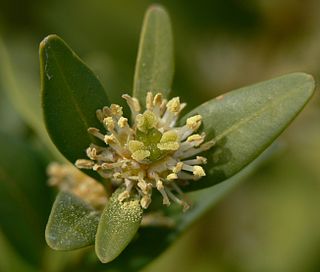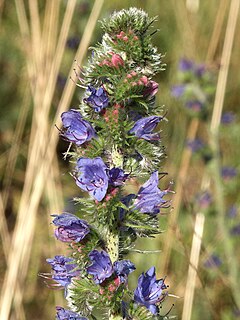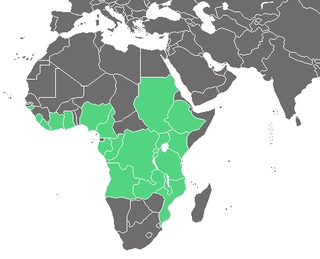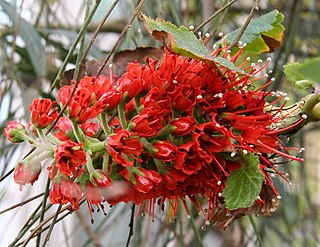
Sapindales is an order of flowering plants. Well-known members of Sapindales include citrus; maples, horse-chestnuts, lychees and rambutans; mangos and cashews; frankincense and myrrh; mahogany and neem.

The Vitaceae are a family of flowering plants, with 14 genera and around 910 known species, including common plants such as grapevines and Virginia creeper. The family name is derived from the genus Vitis.

Ceratophyllum is a cosmopolitan genus of flowering plants including four accepted living species in 2016, commonly found in ponds, marshes, and quiet streams in tropical and in temperate regions. It is the only extant genus in the family Ceratophyllaceae, itself the only extant family in the order Ceratophyllales. They are usually called coontails or hornworts, although hornwort is also used for unrelated plants of the division Anthocerotophyta.

Geraniales are a small order of flowering plants, included within the rosid subclade of eudicots. The largest family in the order is Geraniaceae with over 800 species. In addition, the order includes the smaller Francoaceae with about 40 species. Most Geraniales are herbaceous, but there are also shrubs and small trees.

Geraniaceae is a family of flowering plants placed in the order Geraniales. The family name is derived from the genus Geranium. The family includes both the genus Geranium and the garden plants called geraniums, which modern botany classifies as genus Pelargonium, along with other related genera.

The Francoaceae are a small family of plants in the order Geraniales, including the genera Francoa, commonly known as bridal wreaths, and Tetilla. The Francoaceae are recognized as a family under various classification schemes but under the APG III system the Francoaceae are included within the Melianthaceae. In the APG IV system the Francoaceae are again recognized as a family, with Melianthaceae included in the circumscription of Francoaceae.

The Typhaceae are a family of flowering plants, sometimes called the cattail family. The botanical name for the family has been recognized by most taxonomists.

Scilloideae is a subfamily of bulbous plants within the family Asparagaceae. Scilloideae is sometimes treated as a separate family Hyacinthaceae, named after the genus Hyacinthus. Scilloideae or Hyacinthaceae include many familiar garden plants such as Hyacinthus (hyacinths), Hyacinthoides (bluebells), Muscari and Scilla and Puschkinia. Some are important as cut flowers.

The Angiosperm Phylogeny Group, or APG, is an informal international group of systematic botanists who collaborate to establish a consensus on the taxonomy of flowering plants (angiosperms) that reflects new knowledge about plant relationships discovered through phylogenetic studies.

The Buxaceae are a small family of six genera and about 123 known species of flowering plants. They are shrubs and small trees, with a cosmopolitan distribution. A seventh genus, sometimes accepted in the past (Notobuxus), has been shown by genetic studies to be included within Buxus.

Boraginales is a valid taxonomic name at the rank of order for a group of flowering plants. It includes Boraginaceae and closely related asterid families. The Boraginales include about 125 genera, 2,700 species and its herbs, shrubs, trees and lianas (vines) have a worldwide distribution.

Bersama abyssinica is a species of medium-sized evergreen tree in the Francoaceae family. The leaves are pinnately divided with a strongly winged rachis. The inflorescence is a spike.

Bersama is a genus of small trees in family Francoaceae. The genus is distributed across sub-Saharan Africa.

Greyia flanaganii, commonly known as the Kei bottlebrush, is a species of plant in the Francoaceae family. Greyia flanaganii is one of the related species of the taxonomically isolated and endemic southern African family, the Greyiaceae. Greyia flanaganii is endemic to southeastern South Africa. It is named after Henry George Flanagan, a South African farmer and botanist from Komga, Eastern Cape, South Africa.

The Melianthaceae are a family of flowering plants. The APG II system includes them within the rosid clade. All members of Melianthaceae proper are trees or shrubs found in tropical and southern Africa. Francoaceae are sometimes included in the family, a family consisting of two monotypic genera found in Chile.

Tetilla is a genus of flowering plants. It belongs to the family Francoaceae, which is sometimes included as part of the family Melianthaceae. It has historically been included in the Saxifragaceae.

Vivianiaceae was a family of flowering plants placed in the order Geraniales. The family name is derived from the genus Viviania Cav. It includes both the genus Viviania and Balbisia. The family is now wholly encorporated into the family Francoaceae.

Caryophyllales is a diverse and heterogeneous order of flowering plants that includes the cacti, carnations, amaranths, ice plants, beets, and many carnivorous plants. Many members are succulent, having fleshy stems or leaves. The betalain pigments are unique in plants of this order and occur in all its families with the exception of Caryophyllaceae and Molluginaceae.
The APG III system of flowering plant classification is the third version of a modern, mostly molecular-based, system of plant taxonomy being developed by the Angiosperm Phylogeny Group (APG). Published in 2009, it was superseded in 2016 by a further revision, the APG IV system.

Greyia sutherlandii, also known as Natal bottlebrush, is a species of plant in the Francoaceae family. It is endemic to South Africa.



















